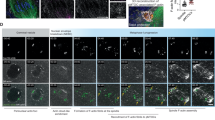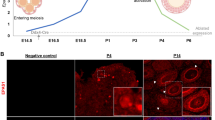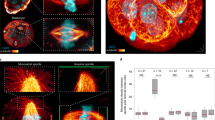ABSTRACT
In this study we used U0126, a potent and specific inhibitor of MEK, to study the roles of MEK/ERK/p90rsk signaling pathway in the meiotic cell cycle of mouse oocytes. The phosphorylation of MAP kinase and p90rsk in the oocytes treated with 1.5 mM U0126 was the same as that in oocytes cultured in drug-free medium. With 1.5 μ M U0126 treatment, the spindles appeared normal as they formed in oocytes, but failed to maintain its structure. Instead, the spindle lost one pole or elongated extraordinarily. After further culture, some oocytes extruded gigantic polar bodies (>30 μ m) that later divided into two small ones. Some oocytes underwent symmetric division and produced two equal-size daughter cells in which normal spindles formed. In oocytes with different division patterns, MAP kinase was normally phosphorylated. When the concentration of U0126 was increased to 15 μ M, the phosphorylation of both MAPK and p90rsk were inhibited, while symmetric division was decreased. When incubating in medium containing 15 μ M U0126 for 14 h, oocytes were activated, but part of them failed to emit polar bodies. MII oocytes were also activated by 15 μ M U0126, at the same time the dephosphorylation of MAP kinase and p90rsk was observed. Our results indicate that 1) MEK plays important but not indispensable roles in microtubule organization; 2) MEK keeps normal meiotic spindle morphology, targets peripheral spindle positioning and regulates asymmetric division by activating some unknown substrates other than MAP kinase /p90rsk; and 3) activation of MEK/ERK/p90rsk cascade maintains MII arrest in mouse oocytes.
Similar content being viewed by others
Log in or create a free account to read this content
Gain free access to this article, as well as selected content from this journal and more on nature.com
or
References
Fan HY, Tong C, Chen DY, Sun QY . Roles of MAP kinase signaling pathway in oocyte meiosis. Chin Sci Bul 2002; 47:1–7.
Abrieu A, Doree M, Fisher D . The interplay between cyclin-B-Cdc2 kinase (MPF) and MAP kinase during maturation of oocytes. J Cell Sci 2001; 114:257–67.
Sturgill TW, Ray LB, Erikson E, Maller JL . Insulin-stimulated MAP-2 kinase phosphorylates and activates ribosome S6 kinase II. Nature 1988; 334:715–8.
Bhatt RR, Ferrell JJE . The protein kinase p90 RSK is an essential mediator of cytostatic factor activity. Science 1999; 286:1362–7.
Gross SD, Schwab MS, Lewellyn AL, Maller JL . Induction of metaphase arrest in cleaving Xenopus embryos by the protein kinase p90rsk. Science 1999; 286:1365–7.
Zhao X, Singh B, Batten BE . The role of c-mos proto-oncoprotein in mammalian meiotic maturation. Oncogene 1991; 6:43–9.
Araki K, Naito K, Haraguchi S, et al. Meiotic abnormalities of c-mos knockout mouse oocytes: activation after first meiosis or entrance into third meiotic metaphase. Biol Reprod 1996; 55:1315–24.
Choi T, Fukasawa K, Zhou RP, et al. The Mos/ mitogen-activated protein kinases (MAPK) pathway regulates the size and degradation of the first polar body in maturing mouse oocytes. Proc Natl Acad Sci USA 1996; 93:7032–5.
Verlhac MH, Pennart HD, Maro B, Cobb MH, Clarke HJ . MAP kinase becomes stably associated at metaphase and is associated with microtubule-organizing centers during meiotic maturation of mouse oocytes. Dev Biol 1993; 158:330–40 .
Gordo AC, He CL, Smith S, Fissore RA . Mitogen-activated protein kinase plays a significant role in metaphase II arrest, spindle morphology, and maintenance of maturation promoting factor activity in bovine oocyte. Mol Reprod Dev 2001; 59:106–14 .
Sun QY, Lai L, Wu GM, et al. Microtubule assembly after treatment of pig oocyte with taxol: correlation with chromosomes, g-tubulin and MAP kinase. Mol Reprod Dev 2001; 99:1–9.
Colledge WH, Carlton MBL, Udy GB, Evans MJ . Disruption of c-mos causes parthenogenetic development of unfertilized mouse eggs. Nature 1994; 370:65–7.
Hashimoto N, Watanabe N, Furuta Y, et al. Parthenogenetic activation of oocytes in c-mos-deficient mice. Nature 1994; 370:68–71.
Verlhac MH, Lefebvre C, Guillaud P, Rassinier P, Maro B . Asymmetric division in mouse oocytes: with or without Mos. Curr Biol 2000; 10:1303–6.
Svoboda P, Stein P, Hayashi H, Schultz RM . Selective reduction of dormant maternal mRNAs in mouse oocytes by RNA interference. Development 2000; 127:4147–56.
Favata MF, Horiuchi KY, Manos E J, et al. Identification of a novel inhibitor of mitogen-activated protein kinase kinase. J Biol Chem 1998; 273:18623–32 .
Lee J, Miyano T, Moor RM . Localization of phosphorylated MAP kinase during the transition from meiosis I to meiosis II in pig oocytes. Zygote 2000; 8:119–25.
Tatemoto H, Muto N . Mitogen-activated protein kinase regulates normal transition from metaphase to interphase following parthenogenetic activation in porcine oocytes. Zygote 2001; 9:15–23.
Su YQ, Rubinstein S, Luria A, Lax Y, Breitbart H . Involvement of MEK-mitogen-activated protein kinase pathway in follicle-stimulating hormone-induced but not spontaneous meiotic resumption of mouse oocytes. Biol Reprod 2001; 65:358–65.
Tong C, Fan H Y, Chen DY, Sun QY . Parthenogenetic activation of mouse eggs induced by cycloheximide is calcium-dependent and can be blocked by okadaic acid. Acta Zool Sin 2002; 48:749–753.
Verlhac MH, Kubiak JZ, Clarke HJ, Maro B . Microtubule and chromatin behavior follow MAP kinase activity but not MPF activity during meiosis in mouse oocytes. Development 1994; 120: 1017–25.
Choi T, Rulong S, Resau J, et al. Mos/ mitogen-activated protein kinase can induce early meiotic phenotypes in the absence of maturation-promoting factor: a novel system for analyzing spindle formation during meiosis I. Proc Natl Acad Sci USA 1996; 93:4730–5.
Galas S, Barakat H, Doree M, Picard A . A nuclear factor required for specific translation of cyclin B may control the accumulation of cyclin B and the timing of first meiotic cleavage in starfish oocytes. Mol Biol Cell 1993; 4:1295–306.
Hyman AA . Centrosome movement in the early divisions of Caenorhabditis elegans: a cortical site determining centrosome position. J Cell Biol 1989; 109:1185–93.
Rhyu MS, Knoblich JA . Spindle orientation and asymmetric cell fate. Cell 1995; 82:523–6.
Lee L, Tirnauer JS, Li JJ, Schuyler SC, Liu JY, Pellman D . Positioning of the mitotic spindle by a cortical- microtubule capture mechanism. Science 2000; 287:2260–2.
Sardet C, Prodon F, Dumollard R, Chang P, Chê nevert J . Structure and function of the egg cortex from oogenesis through fertilization. Dev Biol 2002; 241:1–23.
Lee L, Klee SK, Evangelista M, Boone C, Pellman D . Control of mitotic spindle position by the Saccharomyces Cerevisiae forming Bni1p. J Cell Biol 1999; 144:947–61.
Miller RK, Matheos D, Rose MD . The cortical localization of the microtubule orientation protein Kar9p is dependent upon actin and proteins required for polarization. J Cell Biol 1999; 144:963–75.
Sardet C, Speksnijder JE, Terasaki M, Chang P . Polarity of ascidian egg cortex before fertilization. Development 1992; 221–37.
Evans JP, Foster JA, McAvey BA, Gerton GL, Kopf GS, Schultz RM . Effects of perturbation of cell polarity on molecular markers of sperm-egg binding sites on mouse eggs. Biol Reprod 2000; 62:76–84.
Longo FJ, Chen DY . Development of surface polarity in mouse eggs. Scan Electron Microsc 1984; (Pt–2):703–16.
Longo FJ, Chen DY . Development of cortical polarity in mouse eggs: involvement of the meiotic apparatus. Dev Biol 1985; 107:382–94.
Wassarman PM, Ukena TE, Josefowicz WJ, Karnovsky MJ . Asymmetrical distribution of microvilli in cytochalasin B- induced pseudocleavage of mouse oocytes. Nature 1977; 265:742–4.
Maro B, Johnson MH, Webb M, Flach G . Mechanism of polar body formation in the mouse oocyte: an interaction between the chromosomes, the cytoskeleton and the plasma membrane. J Embryol Exp Morphol 1986; 92:11–32.
Verlhac MH, Lefebvre C, Z.Kubiak J, et al. Mos activates MAP kinase in mouse oocytes through two opposite pathways. EMBO J 2000; 19:6065–74.
Gavin AC, Cavadore JC, Schorderet-Slatykine S . Histone H1 kinase activity, germinal vesicle breakdown and M phase entry in mouse oocytes. J Cell Sci 1994; 107:275–83.
Sun QY, Wu GM, Lai LX, et al. Regulation of mitogen-activated protein kinase phosphorylation, microtubule organi-zation, chromatin behavior, and cell cycle progression by protein phosphatases during pig oocyte maturation and fertilization in vitro. Biol Reprod 2002; 66:580–8.
Schwartz DA, Schultz RM . Stimulatory effect of okadaic acid, an inhibitor of protein phosphatases, on nuclear envelope breakdown and protein phosphorylation in mouse oocytes and one-cell embryos. Dev Biol 1991; 145:119–27.
Sohaskey ML, Ferrell JL . Distinct, constitutively active MAPK phosphatase function in Xenopus oocytes: implications for p42 MAPK regulation in vivo. Mol Biol Cell 1999; 10:3729–43.
Sun ZG, Kong WH, Zhang YJ, Yan S, Lu JN, Gu Z, Lin F, Tso JK . A novel ubiquitin carboxyl terminal hydrolase is involved in toad oocyte maturation. Cell Res 2002; 12:199–206.
Gross SD, Schwab MS, Taieb FE, Lewellyn AL, Qian YW, Maller JL . The critical role of MAP kinase pathway in meiosis II in Xenopus oocytes is mediated by p90rsk. Curr Biol 2000; 10:430–8.
Kalab P, Kubiak JZ, Verlhac MH, Colledge WH, Maro B . Activation of p90rsk during meiotic maturation and first mitosis in mouse oocytes and eggs: MAP kinase-independent and -dependent activation. Development 1996; 122:1957–64.
Tan X, Chen DY, Yang Z, et al. Phosphorylation of p90rsk during meiotic maturation and parthenogenetic activation of rat oocytes: correlation with MAP kinases. Zygote 2001; 9:269–76.
Zhang W, Liu HT . MAPK signal pathways in the regulation of cell proliferation in mammalian cells. Cell Res 2002; 12:9–18.
Acknowledgements
This study was supported by grants from the Special Funds for Major State Basic Research (“973”) Project (G1999055902) of China, National Natural Science Foundation of China (30225010, 30170358) and Knowledge Innovation Program (KSCX2-SW-303, KSCX-IOZ-07) of Chinese Academy of Sciences.
Author information
Authors and Affiliations
Corresponding author
Rights and permissions
About this article
Cite this article
TONG, C., FAN, H., CHEN, D. et al. Effects of MEK inhibitor U0126 on meiotic progression in mouse oocytes: microtuble organization, asymmetric division and metaphase II arrest. Cell Res 13, 375–383 (2003). https://doi.org/10.1038/sj.cr.7290183
Received:
Revised:
Accepted:
Issue date:
DOI: https://doi.org/10.1038/sj.cr.7290183
Keywords
This article is cited by
-
Exogenous Ganglioside GT1b Enhances Porcine Oocyte Maturation, Including the Cumulus Cell Expansion and Activation of EGFR and ERK1/2 Signaling
Reproductive Sciences (2020)
-
Methionine Adenosyltransferase 2β Participates in Mouse Oocyte Maturation by Regulating the MAPK Pathway
Reproductive Sciences (2020)
-
Thyroid hormone enhanced human hepatoma cell motility involves brain-specific serine protease 4 activation via ERK signaling
Molecular Cancer (2014)
-
A soft cortex is essential for asymmetric spindle positioning in mouse oocytes
Nature Cell Biology (2013)
-
The mammalian centrosome and its functional significance
Histochemistry and Cell Biology (2008)



